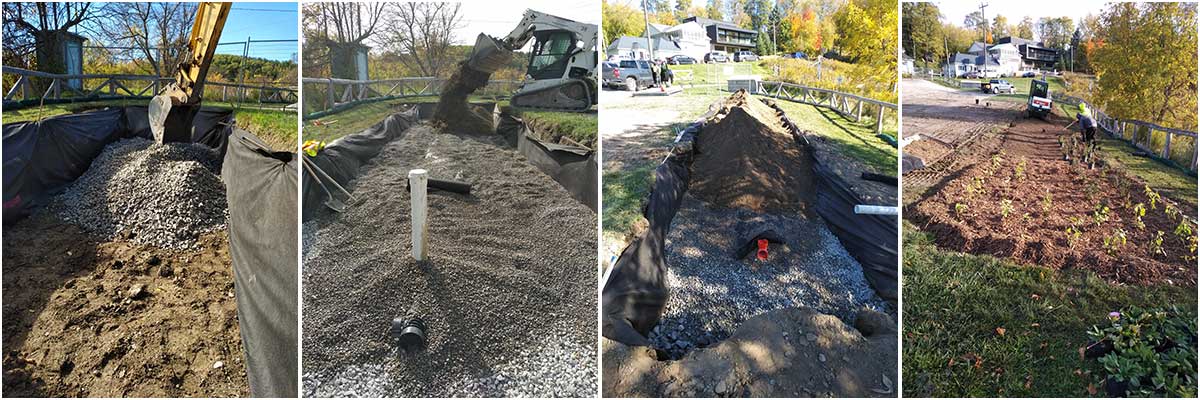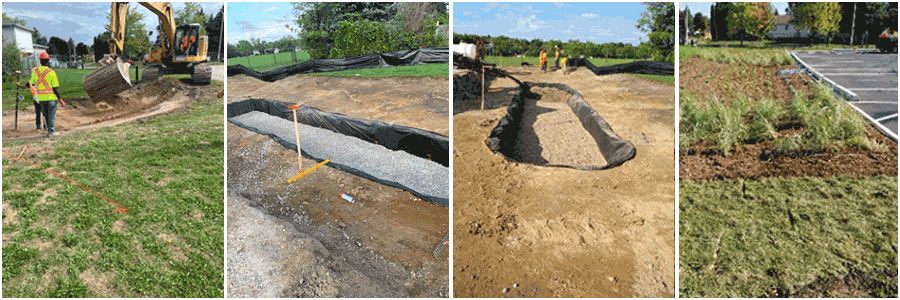Wow, what a year! 2020 was full of challenges but despite the pandemic, our restoration team completed over 50 projects across the Lake Simcoe watershed. From stormwater retrofits, engineered wetlands and permeable pavement, to reforestation, meadow enhancements and online pond removals, we continue to make critical on the ground improvements.
Take a look at some of our favourite projects from 2020 or check out the Lake Simcoe Conservation Foundation’s mini doc for some highlights.
1. Nokiidaa Trail Parking Lot Retrofit

When parking lots need work, it’s an opportunity to do things better.
In partnership with the Town of East Gwillimbury, we recently completed a low impact development parking lot retrofit at the corner of Mount Albert Road and Yonge Street.
The previous parking lot, made of an impervious, hard-packed gravel layer, made it difficult for water to soak into the ground. During major storms, the runoff from the large surrounding area would flow across the parking lot, picking up pollutants along the way. We resurfaced this parking lot and added a bioretention swale which will filter up to 25 cubic metres of stormwater during each major storm event, while reducing the amount of phosphorus and sediment reaching the river.
2. Barrie Parking Lot LID Retrofit

Like the parking lot in East Gwillimbury, the City of Barrie’s Victoria Woods parking lot was made of an impervious, hard-packed gravel. When it came time to resurface the parking lot, we worked with the City to redirect runoff from the new asphalt surface into a bioretention swale.
The new bioretention swale will filter up to 42 cubic metres of stormwater during a major storm event, while reducing phosphorus by 0.5 kilograms per year.
3. It’s all about Infiltration – Testing Permeable Pavers

Permeable pavement was used in the new parking lot at the Town of Aurora’s Community Centre and at the Joint Operations Centre, as well as the Town of Newmarket’s Ray Twinney Centre and Tannery Mall pedestrian trail. Low impact development features, like permeable pavement, allow stormwater to infiltrate into the ground. After over 5 years in action and questions about maintenance, our team completed infiltration testing.
What did we learn? Some areas exceeded industry standard for infiltration but some areas needed work. By replacing the material used in between the pavers, we were able to increase infiltration, going from a 500 mm of stormwater per hour to 11,000 mm!
With seasonal inspections, spring cleaning using a sweeper/vacuum truck, and regular replacement of joint materials, these permeable pavers will continue to work effectively.
4. Marvelous Meadows
Pangman Springs Conservation Area (Whitchurch Stouffville)

Did you know native meadows can take several years to establish from seed? We first seeded the Pangman Springs meadow in 2019 and again this past year using two different methods. We used our new grassland seed broadcaster (funded by the Lake Simcoe Conservation Foundation) to help us seed the meadow area quickly, but we also hand broadcasted our native seeds in those hard-to-reach areas.
We’ll keep watching this meadow transformation over the next two years until all of the beautiful wildflowers start to pop up. We’ll reseed as needed and add some herbaceous plants too.
Rogers Reservoir Conservation Area (East Gwillimbury)

We said goodbye to invasive species and non-native plants during our site preparation at Rogers Reservoir. With the site prepped, we were able to move forward with seeding!
In the Fall, we used a seed drill to help plant seeds at the correct soil depth. We planted native wildflowers and grasses like Canada Wild Rye, Big Bluestem, Blue Vervain, Black-Eyed Susan, Grey-headed Coneflower, Wild Bergamot and Evening Primrose. Fall is a great time to seed for native grasses and wildflowers because it allows the seeds to naturally establish over the winter.
Next year, we’ll seed again and keep watch as the plants start to grow on the nearly 4 hectares of this 4 year project!
5. Preserving and Conserving in Kawartha Lakes

Thanks to a passionate landowner and former cash cropper, a 60-acre farmfield will be transformed into a new meadow habitat, perfect for pollinators and threatened bird species like the Bobolink, Meadowlark and Loggerhead Shrike.
The future meadow was prepped by the landowner by “brush hogging” the land, a method that involves removing all the woody plants and thick weeds to create the ideal conditions for the next step – native plant seeding. With the site prepped and at our recommendation, a Truax drill was used for the seeding – a very specialized and rare tool, but a necessary one to ensures the best results for finer non-agricultural seeds sown at shallower depths.
Come spring those seeds will sprout into restoration action! This project will continue for another couple years as restoration tasks continue to be implemented.
Three Wetland Wonderlands
6. Luck Conservation Area

A fallow 2 hectare field connected to high quality wetland and forest habitat presented the perfect opportunity for restoration. We expanded the wetland at Luck Conservation Area in Innisfil by adding 3 new wetland pockets. These wetland pockets, or vernal pools, will help mitigate the affects of climate change and create new habitat.
To complement the 400 native trees and shrubs planted in 2018, we also planted native wildflower seeds, added more trees and shrubs, and – a first for us – created 3 new habitat mounds which will become homes for species like bank swallows!
7. Cawthra Mulock

What could possibly make Cawthra Mulock Nature Reserve better? Adding a new wetland and planting more trees! We had the pleasure of enhancing this nature reserve by installing 4 hectares of wetland and new natural heritage features. We added 550 live stakes, native seed mix, basking logs, brush piles and standing snags. Plus, we planted over 14,000 trees and shrubs using 24 native species across 6 hectares of land.
8. Circle Park

A wet field in Gilford will soon be transformed into a new wetland! Circle Park, located only 200 metres from Lake Simcoe, was typically wet for 90% of the year, meaning it was an unusable space for residents surrounding the park. To bring this park to its full potential, we created 2 new wetlands to address the drainage problems and we also made sure to leave some park space for the community to enjoy.
All the prep work happened in 2020 so shovels could go in the ground in 2021. Stay tuned for after photos!
9. Surface Water Runoff Reduction
Goodyear Farm, Beaverton
With the runoff-reduction study completed in 2019, we were ready to make some major improvements at Goodyear Farm in 2020. Grassed waterways, sediment control basins, buffers, windbreaks, and new ditches, are all among the many new features installed to reduce the amount of phosphorus, sediment, and other contaminants from reaching Lake Simcoe.
Learn more about this project by watching this one-minute video:
10. Home Sweet Habitat

The challenges of the past year meant that most of us spent more time at home or exploring local greenspaces. And based on the increased number of calls about our restoration funding, many of you added “nature” to your to do list!
Creating and Enhancing Wildlife Habitat was one of our most popular funding categories in 2020. This funding helps watershed residents attract butterflies, birds, and other wonderful wildlife to their own backyards.
Planting native wildflowers and creating a new pollinator paradise were the most popular projects in this category but that’s not all we offer. Planting trees and shrubs, installing bird and bat boxes, and even creating snake hibernacula … we accept funding applications year-round.
Learn more about Enhancing Wildlife Habitat funding or find out how to apply
Lake Simcoe Conservation Foundation

Our work wouldn’t be possible without the generous support of the Lake Simcoe Conservation Foundation. Each year, the Foundation supports environmental programs and projects that help support our vision of a cleaner and healthier Lake Simcoe watershed.
Donate to a cleaner and healthier Lake Simcoe watershed today!
Contact Restoration:
Phone: 905-895-1281
Toll Free: 1-800-465-0437
Email:  restoration@LSRCA.on.ca
restoration@LSRCA.on.ca

